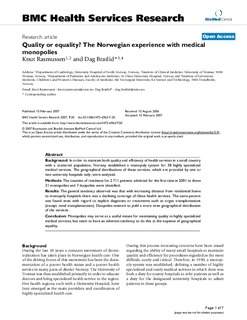| dc.contributor.author | Rasmussen, Knut | |
| dc.contributor.author | Bratlid, Dag | |
| dc.date.accessioned | 2015-09-11T11:23:20Z | |
| dc.date.accessioned | 2015-09-17T14:18:14Z | |
| dc.date.available | 2015-09-11T11:23:20Z | |
| dc.date.available | 2015-09-17T14:18:14Z | |
| dc.date.issued | 2007 | |
| dc.identifier.citation | BMC Health Services Research 2007, 7(1):20 | |
| dc.identifier.issn | 1472-6963 | |
| dc.identifier.uri | http://hdl.handle.net/11250/300633 | |
| dc.description.abstract | Background: In order to maintain both quality and efficiency of health services in a small country
with a scattered population, Norway established a monopoly system for 38 highly specialized
medical services. The geographical distributions of these services, which are provided by one or
two university hospitals only, were analysed.
Methods: The counties of residence for 2 711 patients admitted for the first time in 2001 to these
31 monopolies and 7 duopolies were identified.
Results: The general tendency observed was that with increasing distance from residential home
to monopoly hospitals there was a declining coverage of these health services. The same pattern
was found even with regard to explicit diagnoses or treatments such as organ transplantations
(except renal transplantations). Duopolies seemed to yield a more even geographical distribution
of the services.
Conclusion: Monopolies may serve as a useful means for maintaining quality in highly specialized
medical services, but seem to have an inherent tendency to do this at the expense of geographical
equality. | |
| dc.language.iso | eng | |
| dc.publisher | BioMed Central | |
| dc.title | Quality or equality? The Norwegian experience with medical monopolies | |
| dc.type | Journal article | |
| dc.type | Peer reviewed | en_GB |
| dc.date.updated | 2015-09-11T11:23:20Z | |
| dc.source.journal | BMC Health Services Research | |
| dc.identifier.doi | 10.1186/1472-6963-7-20 | |
| dc.identifier.cristin | 373486 | |
| dc.description.localcode | © 2007 Rasmussen and Bratlid; licensee BioMed Central Ltd. This is an Open Access article distributed under the terms of the Creative Commons Attribution License (http://creativecommons.org/licenses/by/2.0), which permits unrestricted use, distribution, and reproduction in any medium, provided the original work is properly cited. | |
